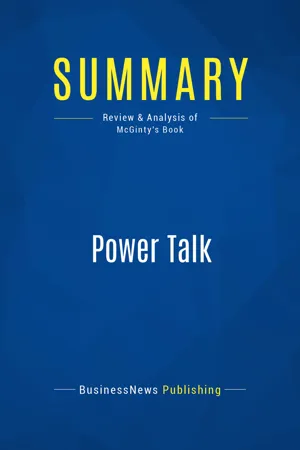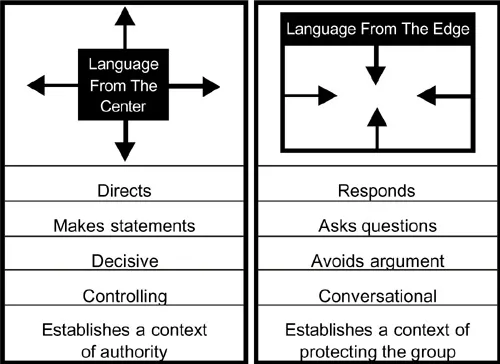
- English
- ePUB (mobile friendly)
- Available on iOS & Android
About this book
The must-read summary of Sarah McGinty's book: `Power Talk: Using Language to Build Authority and Influence`.
This complete summary of the ideas from Sarah McGinty's book `Power Talk` shows that in business, you are what you say, as spoken language is the most influential type of business communication. Thus, being a good communicator means understanding how a situation dictates what style of speech will be most effective and how the style of speech used, in turn, influences the business situation that arises. Knowing the two basic business language styles available and choosing the best allows you to borrow authority from your vocabulary and increase your influence until such time as your expertise and experience levels catch up. This summary will teach you to understand how language actively shapes every situation, and how you can place yourself in a position to build power and credibility.
Added-value of this summary:
• Save time
• Understand key concepts
• Expand your knowledge
To learn more, read `Power Talk` and understand how the language of business can increase your power and influence.
Frequently asked questions
- Essential is ideal for learners and professionals who enjoy exploring a wide range of subjects. Access the Essential Library with 800,000+ trusted titles and best-sellers across business, personal growth, and the humanities. Includes unlimited reading time and Standard Read Aloud voice.
- Complete: Perfect for advanced learners and researchers needing full, unrestricted access. Unlock 1.4M+ books across hundreds of subjects, including academic and specialized titles. The Complete Plan also includes advanced features like Premium Read Aloud and Research Assistant.
Please note we cannot support devices running on iOS 13 and Android 7 or earlier. Learn more about using the app.
Information
Summary of Power Talk (Sarah McGinty)
Section 1: The Two Basic Business Language Styles


- Directs rather than responds. Language from the center attempts to convey as much information as concisely as possible. Thus, directive and decisive statements are made, and any interruptions are cut short and the conversation is bought back to the items on the agenda. The directive speaker will keep everyone on track by using statements like:
- “Getting back to our original concern.”
- “That’s interesting, but we need to focus on…”
- “Okay, but we first need to settle…”
- “Very good. Now I need you to …”
- “Excellent. I hear you. Let’s look at …”
- “Well, to be perfectly candid…”
- “All things being equal, that’s true. But getting back to…”
- “Okay, we can take that as a given, but what about …”
- Makes definitive statements.
Language from the center is functional. Problems are uncovered, potential solutions are discussed and decisions are made. Ideas are delivered directly and forcefully. When language from the center is used, the speaker is the presenter and the listener is the audience – a student learning from the master situation.- “You’ll like the way this has been put together.”
- “I’m sure we can meet budget and achieve our objectives.”
- “We need to look at the bigger picture issues.”
- Decisive – contradicting, arguing or disagreeing as needed.
Language from the center embraces conflict. The speaker confidently and aggressively disagrees with the ideas put forward by other people. This is not, however, an emotional argument but an objective analysis of the factual evidence as more and more proof is gradually disclosed. Thus, language from the center is not abrasive or personal, but bold and willing to commit the audience to the correct decision decisively.- “Yes, you’re right, but is that the right message to send?”
- “A key point to keep in mind is …”
- “Look, the numbers don’t bear that out. You’ll find …”
- “Remember, the alternative does not include …”
- “I’m willing to argue that on closer analysis, …”
- Controlling.
Professionals speak impersonally and with respect for the opinions of others. Language from the center doesn’t require the speaker to become obnoxious. Rather, eye contact, good posture and a moderate tone of voice are used to present information unemotionally and rationally. In total, people using language from the center have the confidence others respect and follow. - Establishes a context of authority.
When someone uses language from the center, the listener is never in doubt where they stand. There is no ambiguity or haziness. The speaker has authority and experience, therefore they are the leader. They use facts (such as numbers, statistics, reports from other experts) to support their claims of authority. The speaker may also might use analogies – previous experiences where the objective under discussion was achieved. A good speaker can often establish their authority by the disclosure of new pieces of information or even context-related humor.- “That’s the same problem we faced at …”
- “This is something I did previously for …”
- “I’ve analyzed this situation and noticed …”
Table of contents
- Title page
- Book Presentation
- Summary of Power Talk (Sarah McGinty)
- About the Summary Publisher
- Copyright